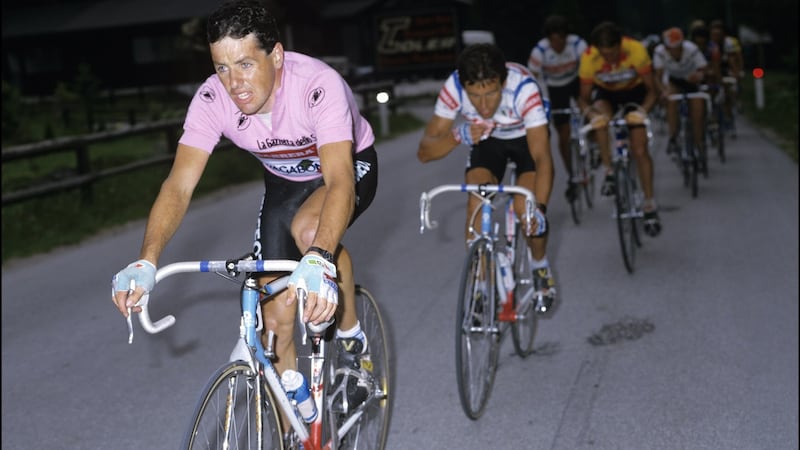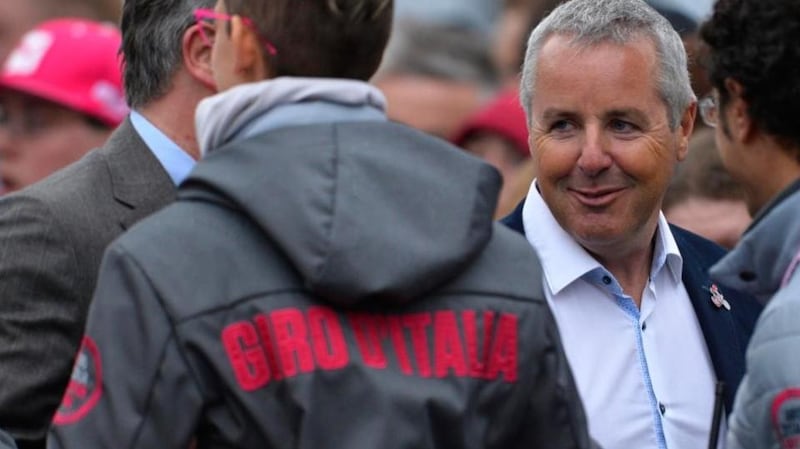It was on the third Sunday and the beginning of the final week when the maglia rosa, among the most sacred of cycling jerseys, finished stage 16 of the Giro d'Italia spattered with spittle of stale red wine mixed with half-chewed pieces of rice, and that was before the rider took it off to discover some mild bruising underneath. That rider was Stephen Roche.
It was the chapter somewhere among the many great volumes of Italian cycling history they still call the Marmolada Massacre. Even with their innate tendency for drama and exaggeration it remains suitably titled.
Because between honour and loyalty, rivalry and upheaval, betrayal and denial, no Grand Tour of cycling has more tales of riders being torn between them all than the Giro, and nowhere was that more evident than the 1987 staging of the race.
Not just because of the two-rider rivalry that frequently spilled over onto the mountainsides and town finishes: more because the other rider was on the same team, the home team, the defending champion and designated co-leader. That other rider was Roberto Visentini.
It was the race that by the turns of the hour or indeed pedal stroke appeared to pit one rider against the other, at times as if deliberately setting out with betrayal in mind. There will always be the Irish and Italian sides to it, the truth perhaps somewhere in between, only what is certain is there could only be one winner.
As Saturday’s Grande Partenza of the 104th Giro sets out from Turin, it seems all such rivalry these days is left on the team buses and replaced by the nicety of the post-race interview, making what unfolded over those three weeks of 1987 all the more startling.
Thursday May 21st, San Remo: 4km prologue time-trial
Roche and Visentini, playful in any pre-race publicity, started in slightly different form and certainly from differing backgrounds.
At the end of 1985, Roche transferred from La Redoute to Carrera, bringing his mechanic Patrick Valcke with him, plus his domestique Eddy Schepers, and there was no denying he was the superstar signing for the top Italian team sponsored by the Verona-based jeans company run by the super-wealthy Tacchella brothers.
Instead it was the most inauspicious of starts, Roche sustaining a crushed knee cartilage injury during the Paris Six-Day track which effectively ruined his 1986 season. He didn't win a single race, dropping out of the 1986 Giro, finishing a distant 45th in the Tour de France, and was already being questioned by the top brass at Carrera.
Team manager Davide Boifava looked to renegotiate the contract, only Roche was having none of it, promising some early season results in 1987.
Roche did exactly that: winning the Tour of Valencia in February, narrowly losing Paris-Nice to Sean Kelly, before through blind naivety finished second in Liège-Bastogne-Liège to Moreno Argentin, the Italian World Champion.
“I think it was the only time I cried after a race,” Roche said in his 2013 autobiography Born to Ride, events of that race further spurring his determination going into the Giro.
In direct contrast to Roche, who started out as an apprentice in Premier Dairies near the family home in the Dublin suburb of Dundrum, Visentini was born into an affluent family of undertakers in Gardone Riviera on the shore of Lake Garda.
Defying the tradition that all great cyclists come from a poor background, where racing is survival and not a hobby, there was no denying his talent. He won the World Junior title in 1975, before turning pro in 1978.
Nor was Visentini ever slow to satisfy his wandering desires, already known for his love of fast cars (one thing at least he did share with Roche) at times he enjoyed la bella vita too. He was like Roche also a magnificently stylish rider. He’d won the 1986 Giro on the day of his 29th birthday, and so two years older than Roche.
The opening two stages were split into a short prologue, short mountain stage, and short downhill time-trial: Visentini won the prologue by .2 of a second, enough to take the lead, before Dutch rider Erik Breukink took the pink jersey on the first mountain ride.
Then, on a treacherous downhill time-trial off the Poggio, Roche won, and after the team time-trial that was the third full stage was won by Carrera, Roche took the maglia rosa, with his teammate sitting second, just 15 seconds back.
Despite sustaining a bruised buttock after crashing on Stage 6 into Terminillo, Roche enjoyed 10 days in pink through Bari and up to Rimini, still on relatively good terms with Visentini, even if the Italian seemed to sit on his every wheel.
Thursday, June 4th, Stage 13, Rimini-San Marino: 46 km individual time-trial
In Born to Ride, Roche singled out this day “where things started to get dusty, before they got dirty, was with that time-trial”. The uphill course should have suited both, only Roche claimed Visentini pestered him all morning about how he intended to ride the stage, including over lunch, and by then Roche “was so wound up that when I got to the start line I had no energy left”.
Indeed the stage ended with Roche’s 25-second advantage decimated,
Visentini killing everyone to win by 1:11, while Roche could only manage 12th, 2:47 back. So the Italian was now in pink, with 2:42 on Roche, in seemingly total command, even with nine stages to go.

Here is where Roche felt betrayed.
“I was devastated after flopping and losing my jersey, and no one could give two hoots. I’d been putting money in the pockets of these guys with all the races that I’d won over the previous six months. I’d been keeping the jersey afloat for the last 10 days in the Giro and now everyone was basically saying ‘Visentini is our man!’”
Then he heard Visentini hint on TV he had no plans to ride the Tour to help Roche, he was “going to the beach”.
There are so many unwritten rules in pro cycling; like when not to attack; or when an attack is not an attack, it’s just not easing up. Either way, that evening with Schepers, his roommate and confidant, Roche planned his counter-attack, and saw potential in the first medium mountain stage to Sappada, two days later, where if any other riders went up the road, he could try follow: “It wasn’t a great plan, but it was the only hope I had.”
Saturday, June 6th, Stage 15: Lido di Jesolo-Sappada, 225 km
Spontaneous perhaps in part, thinking he could at least act like he was defending Visentini’s race lead, Roche bided his time before the descent off the Monte Rest, the first climb of the day.
Two riders had broken away, both miles back on GC, and before the summit Ennio Salvador hit the front of the peloton; Roche strolled up behind, "but once the road started going down, I cut the brake cables".
Another perfectly fearless descent later, Roche was 1:30 clear of the peloton. Visentini and the rest of Carrera were slow to react, prompting the Carrera team car to drive up to Roche, and deliver Boifava’s infamous order that Roche “stop riding”. Also in that car was Valcke, who then shouted at Roche: “Stephen, if you have the balls, today is the day you show them”.
With that Roche simply “went for it”, “eyeballs out”, “so pumped up with anger by the fact my team was riding behind I didn’t feel any fatigue at all”. The peloton inevitably tired, and come the final haul over the Cima Sappada, before the short downhill finish, Visentini was spent, one report the next day describing him as not having enough strength to work the muscles in his face.
Roche lost some ground to Dutch stage winner Johan Van der Velde, 56 seconds down, but by indignation and perhaps reckless ambition, took the overall lead by just five seconds from Swiss rider Tony Rominger. Had Roche not taken over the maglia rosa, things may have turned differently again.
When Visentini finished, 6:50 down, there was poison in the air. He arrived just as Roche was introduced on the finishing podium as the new race leader, prompting Visentini to tell RAI TV, “somebody is going home tonight”.
Roche was taken to his room, while the Tacchella brothers decided what to do next. Roche did get out to give his side of the story to a reporter from Gazzetta dello Sport, only late for the next day’s paper.
In truth Carrera were never likely to send Roche home; Italian loyalty aside, their only real goal was the pink jersey. Those five seconds saved his race, possibly an awful lot more. Still he had six more days in and out of the saddle.
Sunday, June 7th, Stage 16: Sappada-Canazei, 214 km
The Queen Stage, with five major climbs, finishing on the Marmolada – and for Roche that last one a ride through hell. The Sunday morning papers didn’t help.
“I was dubbed Judas by the press for taking the bread out of my teammate’s mouth. Eddy was the ‘Rebel’. Patrick was ‘Satan’. It might have been funny if people hadn’t taken it so seriously.”

The tifosi were ready and waiting, and Visentini wasn’t riding idle either, later admitting to making several attempts to ride Roche off the road.
Roche experienced “mayhem . . . everybody wanted my blood. People were waving banners daubed with images of raw meat dripping blood and saying, ‘Roche Bastardo’, but seeing that hardened my determination . . . there was no way I was going anywhere.”
He tried to hide out in the peloton, his pink jersey a giveaway. It was here that Roche had mouthfuls of rice and wine spat at him, with a few punches landed in between when some Italians got close enough.
“I’d never been so afraid on the bike.”
Roche survived, Breukink now second, 33 seconds down, the likes of the Scot Robert Millar offering some assistance where he could; still it was a long way from the finish in Saint-Vincent. On Stage 19, after another major descent off the Madesimo, and after Visentini attacked, Roche felt a wobbling in his front fork.
At the finish, he released the skewer on the front wheel and “the right blade of the fork fell out”. Even with no evidence of sabotage, from 1992 that incident played on his mind come every big descent. It was also decided Roche should eat in his own room for the remaining days, his masseur preparing his food, as they were afraid someone might poison him.
Saturday, June 13th, 22nd and final stage, Aosta- Saint-Vincent 32 km individual time-trial
Friday’s final mountain stage from Como to Pila, where Roche set out “to drive the final nail into Visentini’s coffin”, and the race was ultimately decided. Roche finished second to Millar, while somewhere back down the peloton Visentini crashed, fracturing his wrist; he finished the stage but didn’t start the final time-trial, his name listed on GC as DNF
All Roche needed to do was stay upright in the time-trial; he won by 14 seconds, finishing with overall winning lead of 3:40 on Millar, Breukink 4:17 in third:
“You only have to look at the Pila stage where I finished second after basically annihilating the whole peloton. There was no debate at all about who was the strongest rider.”
He didn’t hang around afterwards either, driving from Saint-Vincent with two friends and Schepers through the night to his home near Paris.
By the end of the season he’d added the Tour de France and World Championship, joining Merckx as the second rider in history to win that hat-trick in the same year.
Visentini never won another bike race, retiring in 1990 to run the family undertaker business on the shores of Lake Garda.











